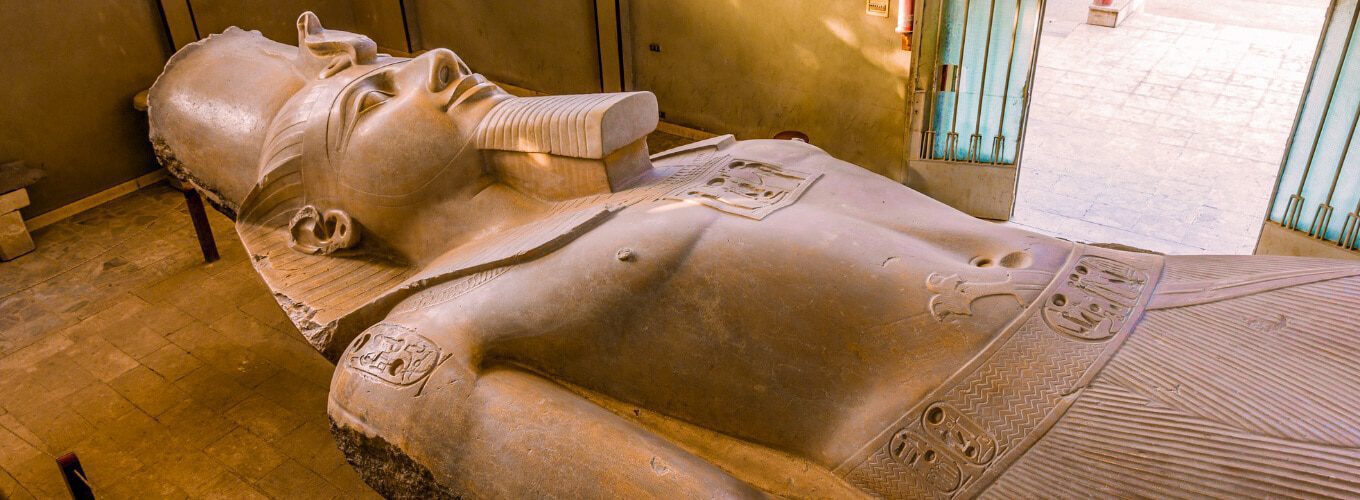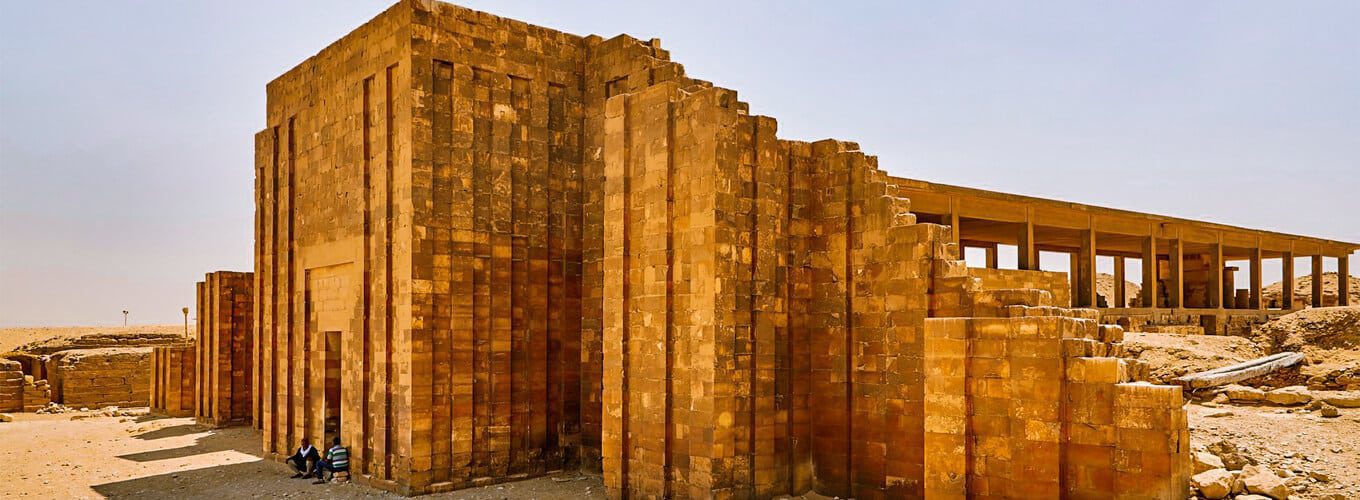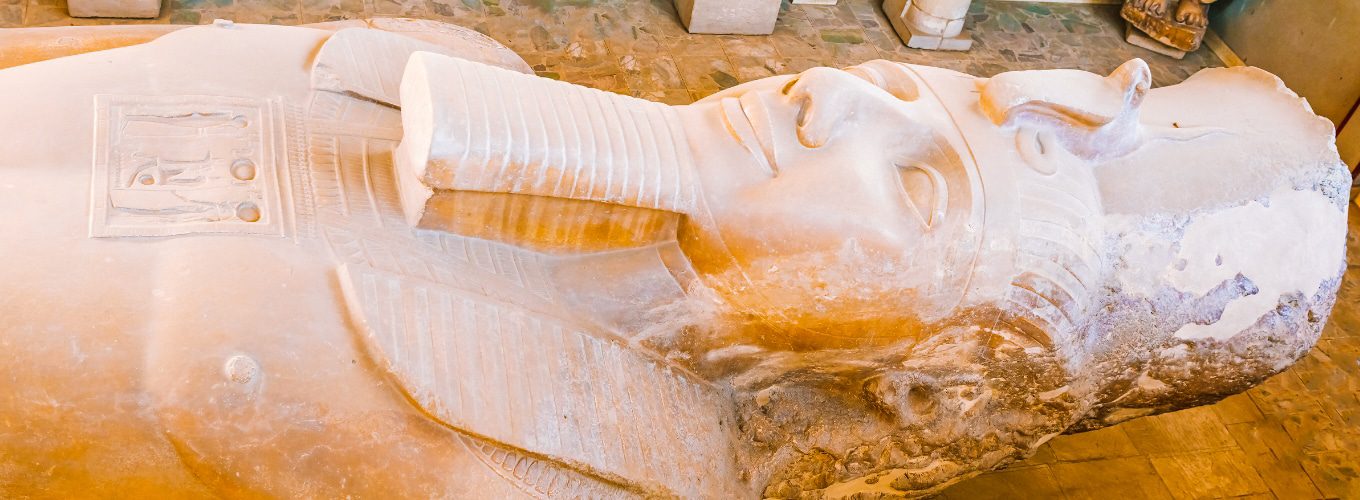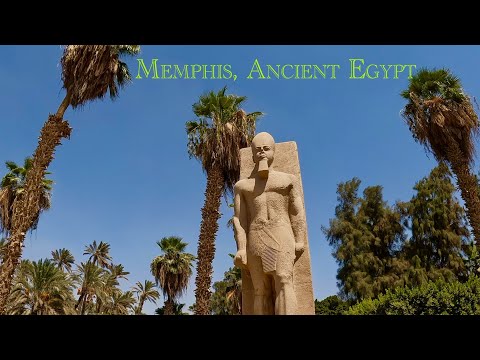What secrets are hidden under the sands of ancient Memphis? This city was the heart of Egypt over 5,000 years ago. It was where legendary pharaohs ruled, leaving a big mark on history and culture.
The City of Memphis is famous for its huge pyramids and statues that have lasted for centuries. These sights still fascinate historians and archaeologists today.
Key Takeaways
- Memphis was the ancient capital of Egypt for over 2,000 years, from the Early Dynastic Period to the Early Middle Ages.
- The city was founded around 2925 BCE by the legendary King Menes, who united Upper and Lower Egypt.
- Memphis reached the peak of its power and prestige under the 6th Dynasty, during the Old Kingdom.
- The Necropolis of Saqqara, located near Memphis, contains important tombs and monuments like the Step Pyramid of Djoser.
- The ruins of Memphis, now a UNESCO World Heritage Site, have yielded remarkable archaeological treasures, including the massive statue of Ramesses II.
Origins and Legendary Founding
The city of Memphis, Egypt, has a long and interesting history. It was founded by Legendary King Menes, who united Upper and Lower Egypt into one kingdom. This was during the Early Dynastic Period.
Menes made his capital on the Nile’s banks. He built dikes to keep the city safe from floods.
Mythical Tales of Memphis’ Establishment
The Greek historian Herodotus also tells a story about Menes. He says the Persians kept the dikes in good shape to protect the city. But, some think Menes might not have been real. They believe Egypt became one through cultural and trade links.
An inscription about predynastic King Iry-Hor was found. It could mean he helped start Memphis.
Connection to Menes, the First Pharaoh
Even if we’re not sure how it started, Memphis is key in ancient Egyptian history. The story of Legendary King Menes and the Unification of Upper and Lower Egypt made Memphis important. It helped start the Old Kingdom dynasties that shaped Egypt’s future.
Toponymy: The Many Names of Memphis
The ancient Egyptian city of Memphis had many names. Each name showed its importance and growth. The first name was Inebu-hedj, meaning “the white walls.”
It was also called Djed-Sut (“everlasting places”) and Ankh-Tawy (“Life of the Two Lands”).
Another name was Men-nefer, meaning “enduring and beautiful.” This name turned into Memfi in the Bohairic Coptic language. The Greeks called it Μέμφις (Memphís).
In the Bible, it was known as Moph. The Muslim tradition used the Coptic name Māfah, from the word for “thirty.”
These names highlight the Ancient Egyptian Toponymy of Memphis. It was Egypt’s capital for over two millennia. Names like Inebu-hedj, Djed-Sut, Ankh-Tawy, Men-nefer, Memfi, Moph, and Māfah show its lasting importance and cultural impact.

Strategic Location and Population
The ancient city of Memphis was in a key spot. It was 20 km (12 mi) south of today’s Cairo, on the Nile River’s west bank. It was where Upper Egypt and Lower Egypt met.
Now, the towns of Mit Rahina, Dahshur, Abusir, Abu Gorab, and Zawyet el’Aryan are part of Memphis.
Some say Memphis had up to 30,000 people at its peak. This would have made it one of the biggest cities in the world back then. Others think it had about 6,000 people during the Old Kingdom.
Geographical Position and Growth
Memphis was at a great spot on the Nile River Delta. It was where Upper Egypt and Lower Egypt met. This helped it grow into a big city.
It became a center for trade, commerce, and culture. This made it a key city in ancient Egypt.
|
Population Estimates |
Time Period |
Source |
|
Around 30,000 inhabitants |
Peak of the city |
T. Chandler |
|
Around 6,000 inhabitants |
Old Kingdom |
K. A. Bard |
Ancient City of Memphis Egypt: Capital of Two Lands
In the Early Dynastic Period and the Old Kingdom, Memphis was the top city in Kemet (ancient Egypt), also called Kumat. It was a key place for over six dynasties. The city was most powerful under the 6th Dynasty, being a big center for the god Ptah. Ptah was the god of craftsmen and artisans.
Memphis was a busy city as the capital of Ancient Egypt. It had a main port called Peru-nefer. This port was full of workshops, factories, and warehouses. These places helped send goods all over the ancient kingdom.
The city was in a great spot at the Nile delta, about 20 kilometers south of today’s Cairo. This made it very important for trade and government.
|
Fact |
Statistic |
|
Year Memphis was Built |
3200 BC |
|
Peak Population |
Around 30,000 inhabitants |
|
Period of Most Populous City in the World |
Until approximately 2250 BC |
|
Recognition as a World Heritage Site |
1979 |
|
Height of Sphinx in Open Air Museum |
4 meters |
|
Length of Sphinx in Open Air Museum |
7 meters |
|
Weight of Sphinx in Open Air Museum |
80 tons |
Since 1981, archaeologists have been studying Memphis and its area. They are from the Egypt Exploration Society. Their work has taught us a lot about Memphis’s history and its role as the capital of Ancient Egypt. They’ve also learned about how the Nile delta changed over time.
Religious and Cultural Significance
Ancient Memphis was a city full of deep religious and cultural meaning. At its heart was the worship of Ptah, the god of craftsmen and artists. The city’s main temple, the “Hut-ka-Ptah,” showed how important Worship of Ptah was to the city’s spiritual life.
Ptah, his wife Sekhmet, and their son Nefertem made up the Memphis Triad. This group was the main focus of the city’s worship. The Memphite Theology showed how smart and deep the city’s priests were in their beliefs.
But Memphis was more than just a place of worship. It was also famous for its Arts and Crafts. The beautiful funerary objects and the detailed tomb reliefs show the city’s high level of Philosophical Sophistication and art.
|
Deity |
Role |
Significance in Memphis |
|
Ptah |
Patron of craftsmen and artisans |
Central figure of worship in the city, with the Hut-ka-Ptah temple as a prominent structure |
|
Sekhmet |
Ptah’s consort |
Part of the Memphis Triad, along with Ptah and Nefertem |
|
Nefertem |
Ptah and Sekhmet’s son |
Part of the Memphis Triad, representing the mythical origins of the city |
Architectural Marvels and Necropolises
Memphis was the ancient capital of Egypt. It’s known for the Pyramid Fields and necropolises west of the city. These royal pyramid tombs show Memphis’s importance in the Old Kingdom.
Pyramids and Monuments of the Old Kingdom
The Step Pyramid of Djoser at Saqqara was a big deal. It was made by Imhotep, the king’s architect. The three big pyramids at Giza were built later by 4th Dynasty kings.
There are also other pyramids near Memphis that were never finished. Queen Hetepheres’s hidden tomb is special. It shows off the amazing Old Kingdom Arts and Crafts of that time.

|
Monument |
Pharaoh |
Dynasty |
|
Djoser’s Step Pyramid |
Djoser |
3rd |
|
Giza Pyramids |
Khufu, Khafre, Menkaure |
4th |
|
Sneferu’s Pyramids |
Sneferu |
4th |
|
Hetepheres’ Tomb |
Hetepheres |
4th |
The Pyramid Fields and necropolises of Memphis show the Old Kingdom’s skill. The famous Giza Pyramids and other structures amaze people from all over the world.
Decline and Abandonment
The city of Memphis was once a powerful place in ancient Egypt. It was the capital for over 3,000 years. But, things changed after the 18th Dynasty. The power moved north to Thebes, starting a new chapter in Egyptian history.
Even so, Memphis got a second chance under Persian rule. But, it was soon overshadowed by Alexandria. When the Romans took over Egypt, Alexandria became the top city. Memphis was left as the second city, until Fustat (or Fostat) was made the new center in 641 AD.
After that, Memphis was mostly forgotten. By the 12th century, it was just ruins and scattered stones. It was a shadow of its former glory.
- Memphis served as the capital of Ancient Egypt for more than eight dynasties during the Old Kingdom.
- Estimates suggest Memphis had a historical population of about 30,000 people.
- Archeologist Kathryn A. Bard estimates that Memphis had a population of no more than 6,000 during the Old Kingdom.
The fall of Memphis was a slow process. It lost its importance in politics, economy, and culture over time. Today, the ruins of this great city are still being studied and saved. But, Memphis is now just a shadow of its former self.
Memphis Ruins and Open-Air Museum
Memphis was once the grand capital of ancient Egypt. It now stands as an open-air museum. It shows us the remains of this amazing civilization. Founded around 3100 BC by King Narmer, Memphis was the capital for over eight centuries.
Then, Thebes became the new capital in the New Kingdom.
Remnants of a Great Civilization
The open-air museum of Memphis is called Mit Rahina. It has many artifacts and architectural wonders. Visitors can see the huge Statue of Ramses II, over 10 meters tall, made from one piece of limestone.
Close by is the Alabaster Sphinx, a massive 4-meter-high, 7-meter-long statue. It weighs 80 tons and honors the pharaoh Hatshepsut.
The museum also has the foundations of the Great Temple of Ptah. This was once Memphis’s most important temple. It shows how grand the city was.
Other sights include the Temple of Hathor, the Temple of Apepi, and old palaces and buildings.
Outside the museum, the Saqqara Necropolis and the Dahshur Pyramids are also worth seeing. The Saqqara Necropolis has the Step Pyramid of Djoser and other important sites. The Dahshur Pyramids show how pyramid design changed over time.
The Memphis open-air museum is open from 8 am to 4 pm every day. Adults pay 80 EGP to enter, and students pay 40 EGP with a valid ID. It’s a chance to dive into ancient Memphis and learn about its important role in Egypt’s history.
Conclusion
Memphis was a key city in ancient Egypt, being the capital for over 2,000 years. It was a place of great history, with many dynasties rising and falling. Its location, religious importance, and amazing buildings made it a UNESCO World Heritage Site.
Even though Memphis is now abandoned, its old buildings are still fascinating. They show us the amazing things the Pharaonic Heritage achieved. Visitors and scholars are still drawn to its ruins.
The history of Memphis shows how clever and strong the Pharaonic people were. From its founding stories to its big monuments, Memphis left a big mark on the world. Thanks to ongoing digs and research, we learn more about this city.
This keeps the UNESCO World Heritage Site status of Memphis alive. It means we can keep celebrating Memphis for many years.
For over 200 years, many people have worked to learn about Memphis. They’ve shown us how interesting this part of Egyptian history is. Memphis teaches us why we must protect our cultural heritage.
Read our related articles:


